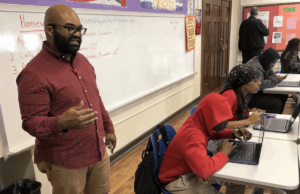Engaging Online Idaho School Gains Top Marks

When we saw that Idaho Distance Education Academy (I-DEA) had earned 5 stars–top on Idaho’s school ranking system–we called director Jason Bransford to learn more. We found a story worth sharing.
Nine years ago, the Whitepine Joint School District (east of Moscow) launched the online school to draw homeschoolers back into the public system. These days I-DEA is one of five statewide virtual schools and the only one chartered under a school district.
Serving 825 K-12 students, I-DEA serves a wide range of students–some bored, some striving to accel, some struggling to catch up, some have health challenges–all looking for more opportunity and personalization than afforded by their local school.
Seven years ago, a I-DEA job posting caught the eye of a Houston teacher having a successful online experience while earning his masters degree. Jason Bransford saw a chance to take on a leadership role in a growing school. He moved his family to Pocatello, to head up the southeastern support center for I-DEA and a few years later he was directing the statewide program.
Three innovations appear to be driving the academic results:
- Anchor assignments in all classes: big projects that result in ownership and evidence of learning;
- Curricular choice in all classes: multiple textbook options including online and hardcopy; and
- Dual enrollment in upper grades: students take online and onsite college classes.
Projects are not very common in online learning but at I-DEA they are the academic spine of the school. There is a mixture of individual and team-based projects. With the goal of helping students appreciate the value of what they are learning, projects are rigorous and relevant. Collaboration is important at I-DEA. Students collaborate through technology to provide peer feedback to one another on projects–and it is part of their grade.
When Bransford arrived, the school was making progress, but still regularly missing AYP targets. He asked, “What can we do to achieve academic excellence?” The administrative team decided that, in addition to challenging projects, they would create a structure that encourages students to take college courses–but do it in fiscally responsible way. I-DEA requires parents to pay for their child’s college classes but the school reimburses them for completion with a grade of C or better. Students can attend any public college in Idaho as long as they align with high school requirements. They counsel with students on benefits but screen for readiness to ensure they are academically successful. If families can’t afford the upfront payment, a grant program covers the cost. Almost 80% of I-DEA students graduate with at least one college course and around 20% complete associate’s degree with their high school diploma–saving two years and more than $30,000.
I-DEA runs on the free and open Moodle platform with the Mahara ePortfolio System. They use multiple content vendors so students can have choice in finding what learning resources work best for them, individually.
The majority of students are full time. In the education of elementary students, “Parent play a huge and vital role–we ask a lot of them, probably more than any others,” said Bransford. Frequent assessment is to make sure progress is being made appropriately.
“If you are not showing one years growth, there is a lot of tutoring support, right away,” said Bransford. Most of the 22 full time teachers have master’s degrees and at least three years of successful teaching in a traditional classroom. They talk about individual students every month and find individual intervention strategies to help.
There is an I-DEA administrator at each of three resource centers. The staff is distributed–some work at the resource centers, some work remote. “Everyone wears multiple hats,” said Bransford, “but it works out well in practice.”
In addition to the top rating on the Idaho report card, I-DEA met AYP for the last two years and is an Albertsons Foundation “Go-On School” for boosting college enrollment. I-DEA was awarded the Innovators of the Year from the Idaho Education Network. The 30 to 35 graduates each year leave with “lots of scholarship money.”
Next month I-DEA launches a Cisco certification program–the first time this is being offered online.








0 Comments
Leave a Comment
Your email address will not be published. All fields are required.